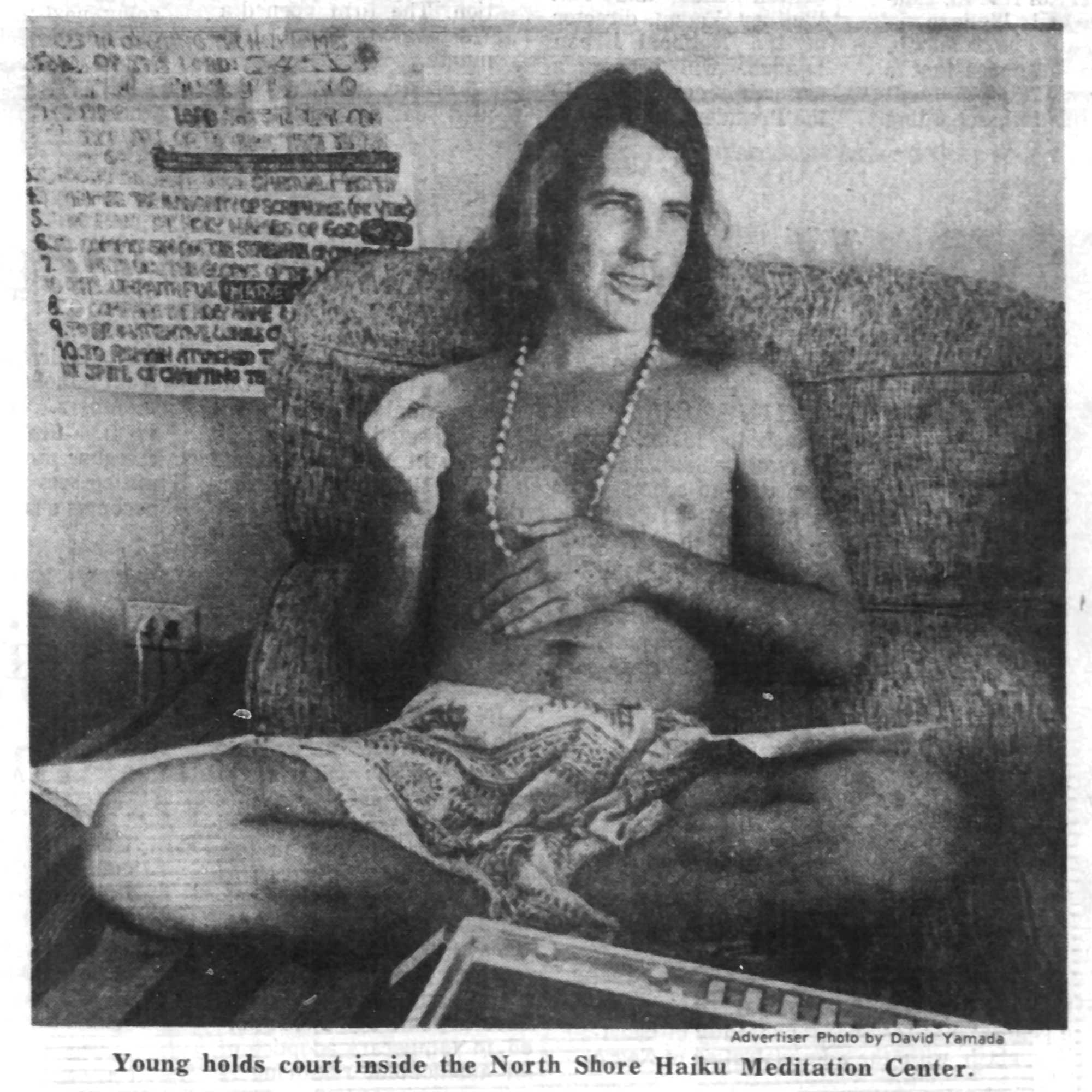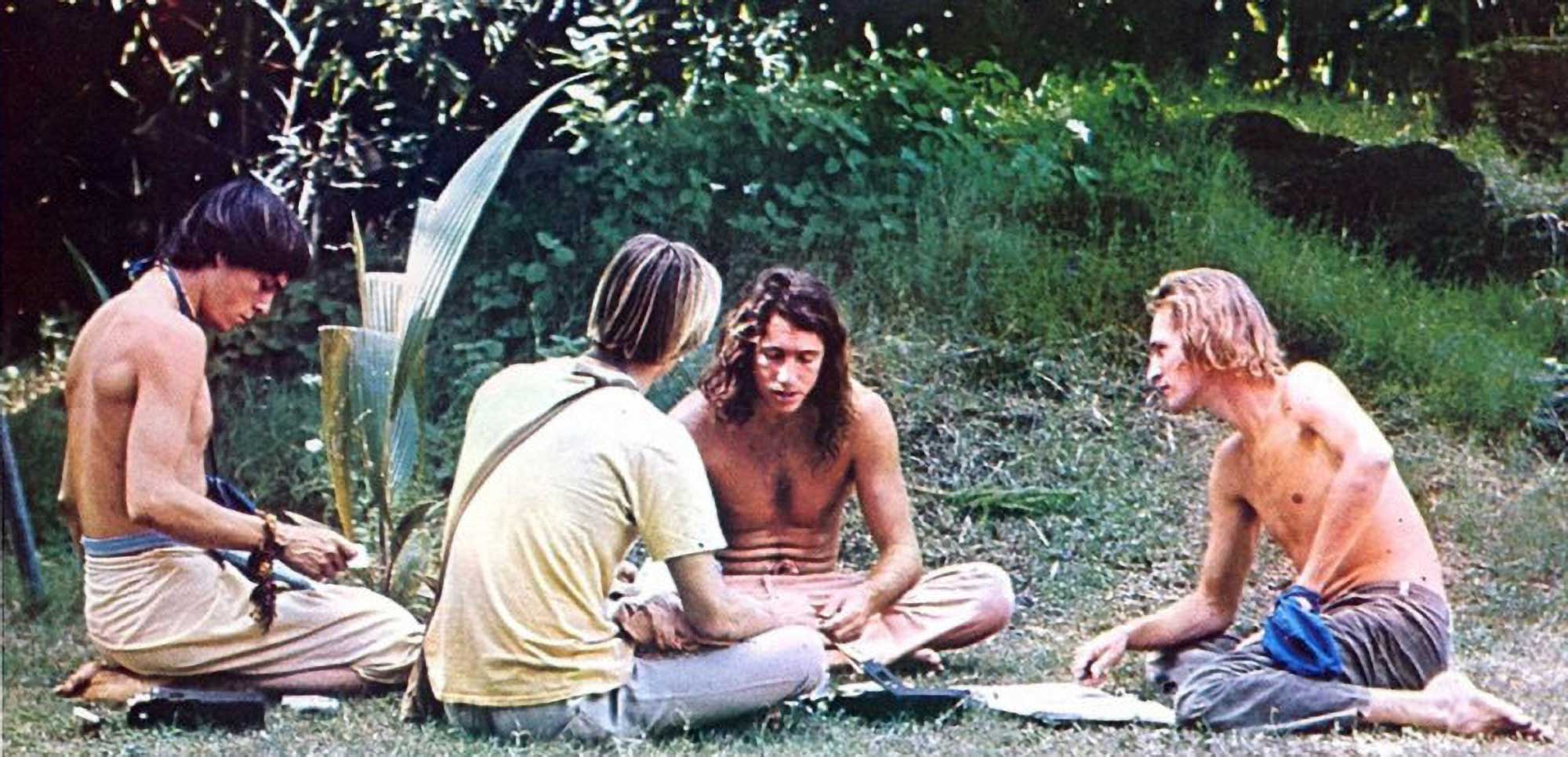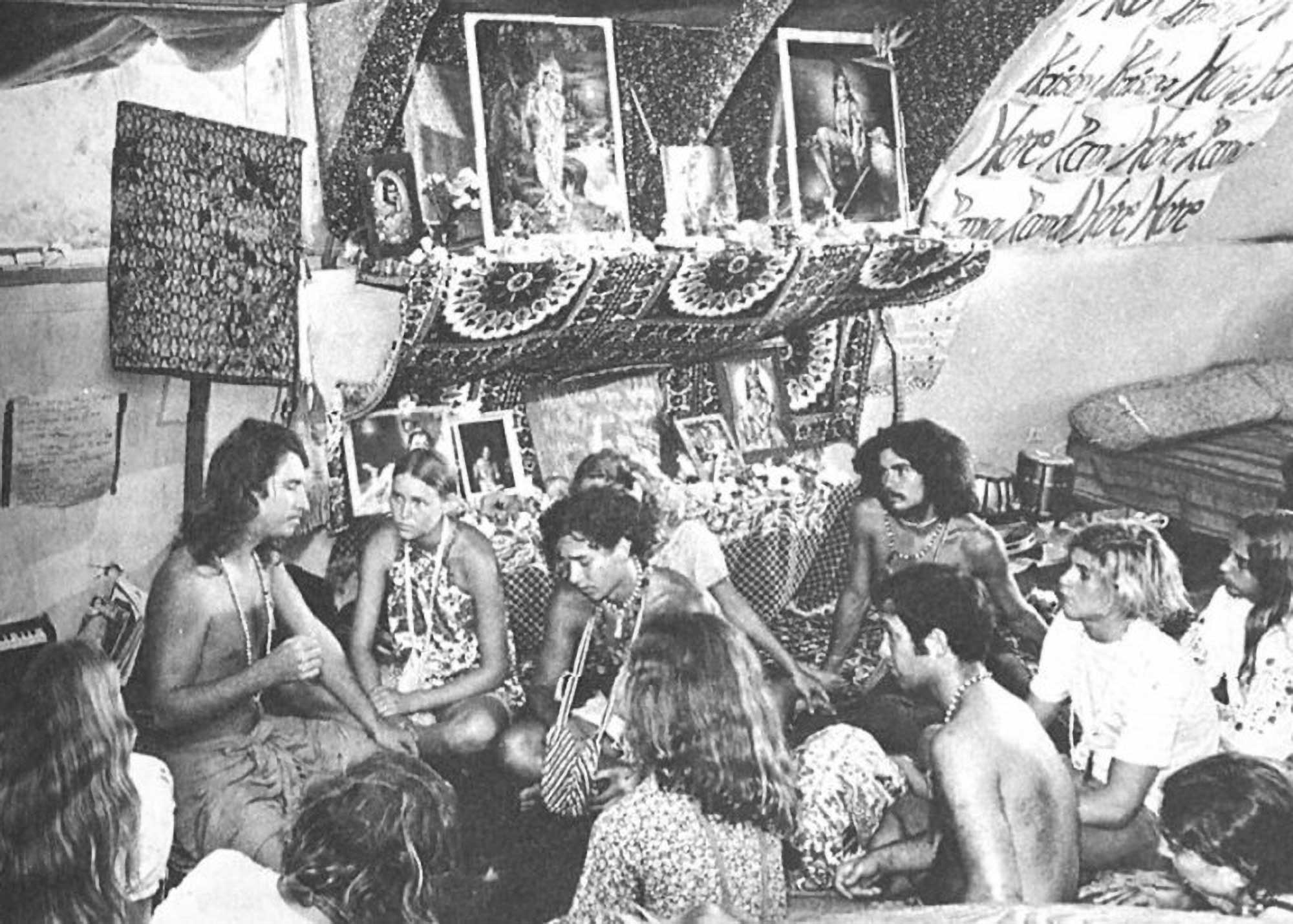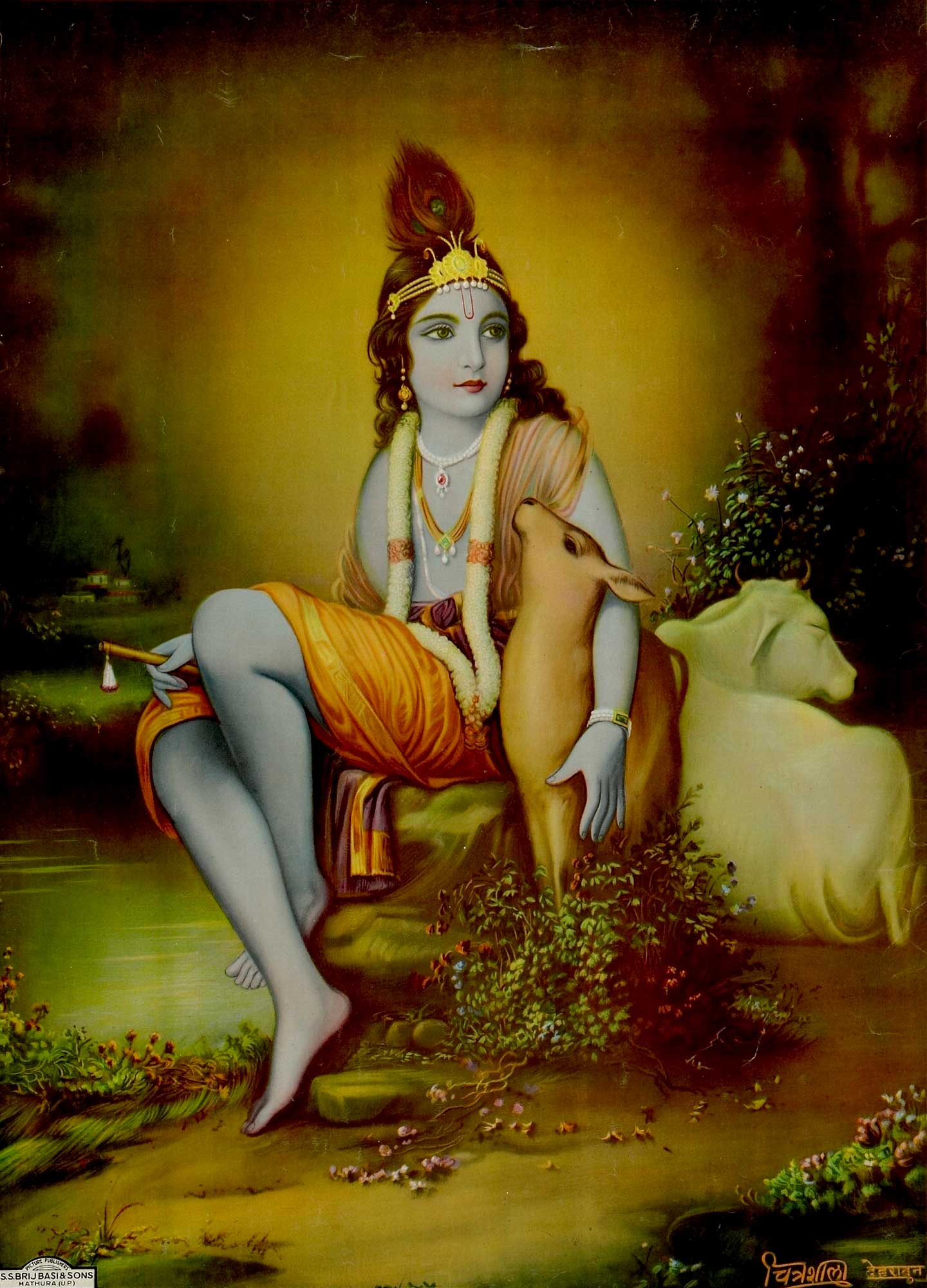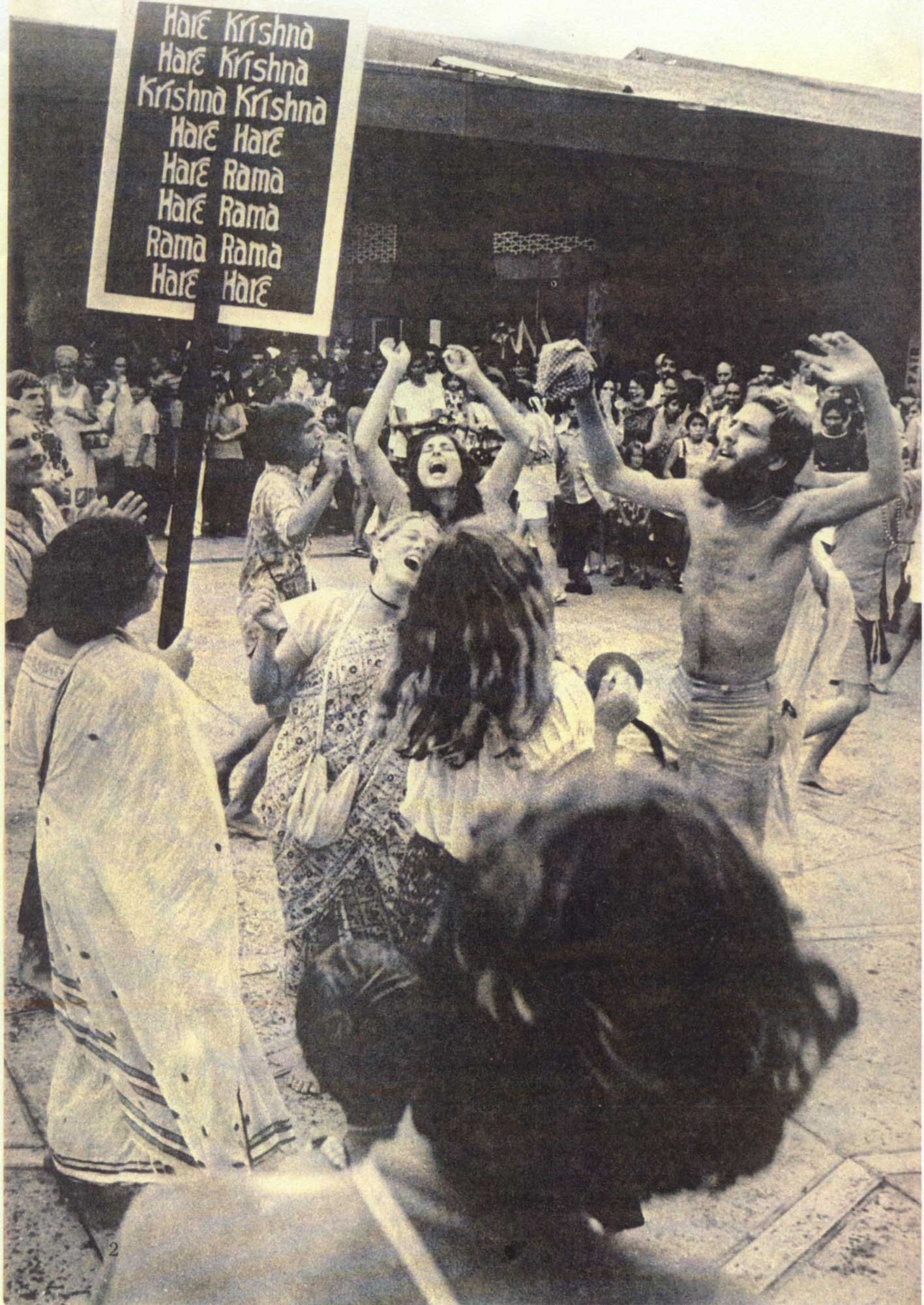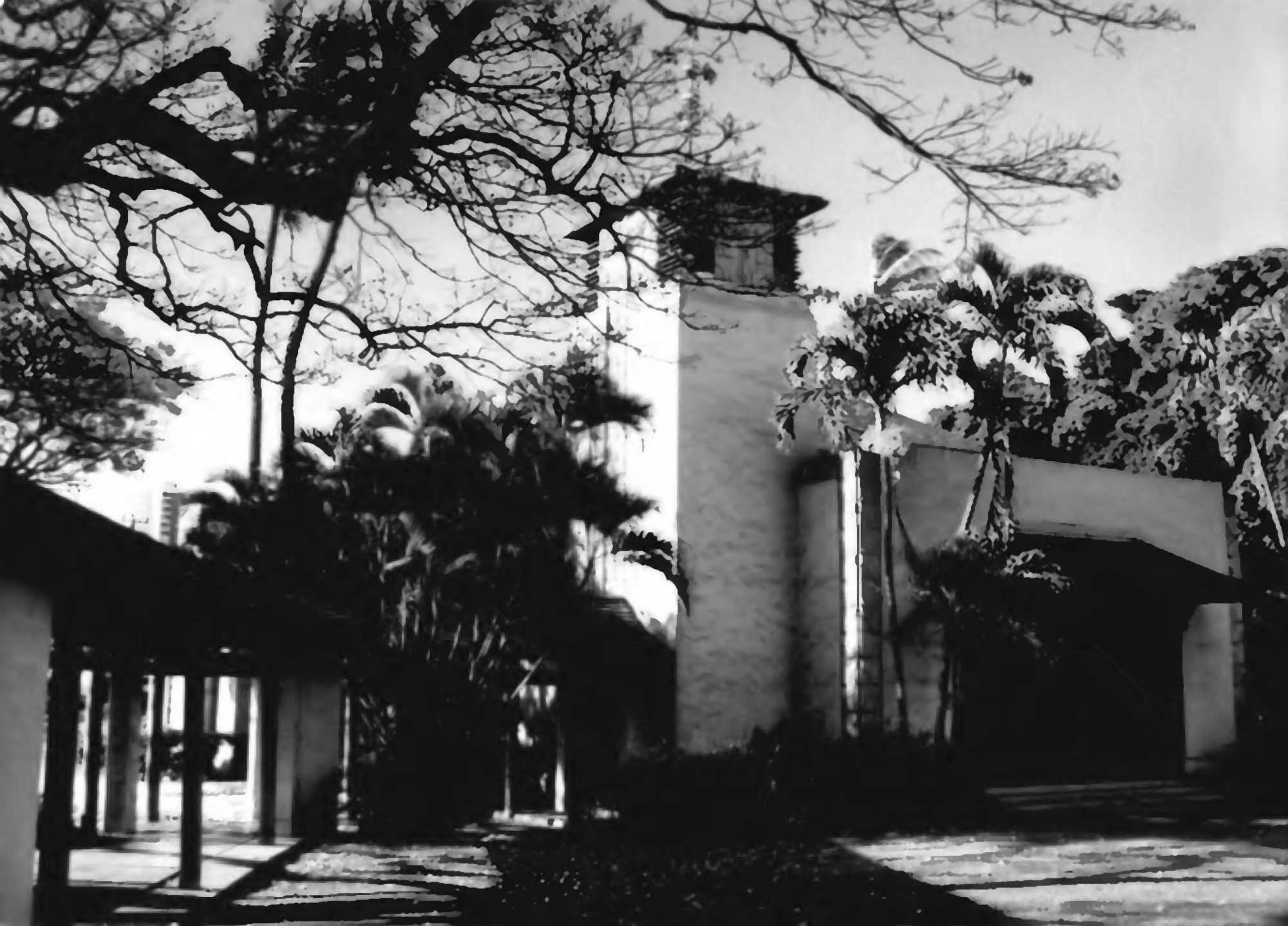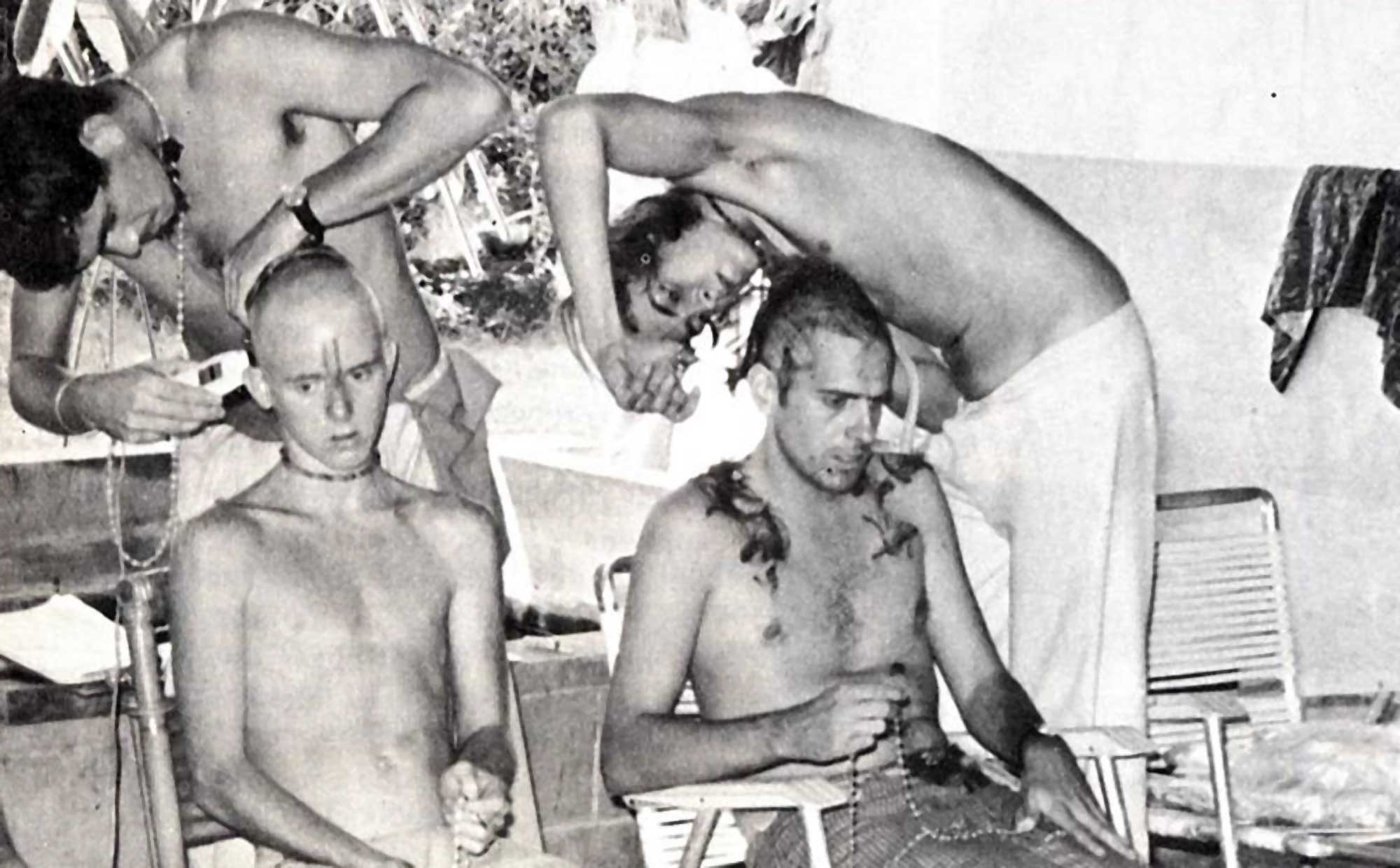Ācārya Siṁha
The Life of Swami Bhakti Gaurava Narasiṅgha Mahārāja
Chapter 6 – Sai and the KYC
(1970)
The Haiku Meditation Center was presided over by a well-known American yoga-instructor and self-appointed guru named Sai. His original name was Chris Butler and although born in New Orleans, he had moved to Hawaii with his family when he was an infant. Like most young people at that time, Sai had experimented with LSD and claimed that during one of his trips he had a ‘divine awakening’ and that the title ‘Sai’ (a Persian word meaning ‘master.’) had been given to him by Kṛṣṇa Himself. He then founded the Haiku Meditation Center (also known as the Haiku School of Nirvana Yoga) where he gave classes on kuṇḍalinī and aṣṭāṅga–yoga. As was the case with most spiritual movements of that era, Sai’s teachings were impersonal and centred around how one could become God.
A picture of Sai in the Local Newspaper
Sai was an extremely charismatic individual who had many followers in Hawaii. He would give lectures at the Church of the Crossroads in Honolulu, and Sunset Beach, two popular meeting places for many spiritual seekers. Then, on New Years Day, at the Sunshine Music Festival at Diamond Head crater, Sai met two disciples of Śrīla Prabhupāda, Gaurasundara Dāsa and Govinda Dāsī who gave him a Bhagavad-gītā. This was a huge turning point for Sai. which led to him visiting the Iskcon temple where he chanted with the devotees and took prasādam. Sai was captivated by the chanting of the Mahā-mantra and when he returned to his āśrama, he incorporated the chanting in his āśrama program as a tool for impersonal realisation. However, by the influence of his initial meeting with these disciples of Prabhupāda and from reading Bhagavad-gītā – As It Is, Sai eventually abandoned the path of yoga and impersonalism and began practicing Kṛṣṇa consciousness. However, despite taking up bhakti-yoga and reading Prabhupāda’s Gītā, he decided to remain totally independent from Iskcon.
Narasiṅgha Mahārāja: I entered the Haiku Meditation Center at its flowering moment. It had seeded, stemmed, grown, and budded before I arrived. By the time that I got there, in about one year it was pretty exceptional. It was basically a farm. I don’t know how big it was, but I do know the total value of the place without counting any of the little things, was very expensive. I remember they had a pretty well-equipped kitchen back in those days with a huge stainless steel refrigerator etc. Sai had another branch in Honolulu and a center at Sunset Beach which had its own little culture of people there.
Sai (center) with followers at the Haiku Meditation Center
Narasiṅgha Mahārāja came to stay with Sai and his followers during a period of transition. Sai and his followers had already begun doing saṅkīrtana in various places (such as the Banana Patch), offering their food to Kṛṣṇa, and the Center had Indian devotional paintings all over the walls. When Mahārāja joined, it was still known as the Haiku Meditation Center, but Sai was in the process of changing it’s name.
Sai giving a class to his followers at the Haiku Meditation Center
Members would wake up at 5:00am, chant sixteen rounds, read from Prabhupāda’s books, offer their food to Kṛṣṇa, go out on hari-nāma saṅkīrtana and follow the four regulative principles of no meat-eating, no illicit sex, no gambling and no intoxication (no intoxication certainly set them apart from all other spiritual groups of the time!). Life at the Center was very regimented and pretty austere – Sai’s right-hand man would frequently walk around during japa period with a jug of ice-water to pour down the necks of anyone who was falling asleep while chanting. Meals were very plain. One of Mahārāja’s friends from the Banana Patch named Matt (who later became Prabhupāda’s disciple, Puṣkara Dāsa) joined Sai around the same time, and remembers:
Puṣkara Dāsa: We ate very austerely in those days. Sai, of course, had his own bungalow and menu. I remember clearly that Mahārāja became the cook, but they didn’t give him many things to cook with. He mostly prepared soup and bread with a few carrots and some vegetables that were gathered from around the area.
Many times, when food was scarce, the group would have to steal food from nearby farms.
Narasiṅgha Mahārāja: On the side of what the tourists called the ‘Likey Likey Highway’ there were these massive commercial banana fields that had been there since before World War II. Myself and Chiranjib would go over there and heist bananas. But it got pretty sketchy a few times. Sometimes they were out there with patrol trucks and spotlights scanning the fields. We would pick one that even if we were spotted we could make a quick getaway – at least we hoped! But Chiranjib and I did get pinned down one night. At around 2 o’clock in the morning we’d taken about fifteen new stalks. We had timed everything. We knew when the truck with the spotlights would come, so we had all the bananas lined up in one little spot. We figured it would take less than a minute for us to go to that spot, throw all the stuff in our jeep and drive away.
The truck comes right on time and we’re ready. We’re lying flat while these guys light up all the trees with these big mounted floodlights. Generally, they’d scan the area for a few minutes and leave, but that night they stayed on. We had to lie there in the grass for way over an hour, and that was one miserable hour! I can remember getting bit up by all sorts of critters. The worst thing was that if these guys found our stash of bananas, they’d know we were around and they would not stop till they caught us. I was thinking, “They’ll run over us! They’ll squash us with their trucks!” I was freaking out. But these plantation workers were usually drunk and they couldn’t see much…so we got away. We had a whole two-car garage full of green bananas hanging. We had a lot a lot of banana bread in those days.
Since Sai was already a guru with followers, he had them chant his praṇāma-mantra which was based upon Śrīla Prabhupāda’s. He eventually decided to give initiations for the first time, but Mahārāja wasn’t amongst the initiates. He wasn’t sure why Sai had never asked him to take initiation, but it may have been due to the fact that Mahārāja already had some experience of Kṛṣṇa consciousness. He had already been chanting japa and offering his food to Kṛṣṇa a year before he came to the Haiku Meditation Center. Sai’s attitude may also have been due to Mahārāja’s independent nature.
Puṣkara Dāsa: Mahārāja and I were the least surrendered out of the group. We were the only ones in the whole community not to receive Sanskrit names from Sai. We were not totally sold out. We knew he was a far out guy, but we had some doubts about Sai.
Mahārāja noted Sai’s standoffish behaviour towards him and felt that this may have had something to do with a couple of incidents that happened a few weeks before the initiations.
Narasiṅgha Mahārāja: During a gathering, I asked a question which really annoyed him. There’s that famous Brajbasi painting of Gopāla Kṛṣṇa with the cow – it was a favourite for many of us, including Sai. So there’s a deer in the picture standing at Kṛṣṇa’s side, and I asked him, “What’s the position of the deer?” Now, in hindsight, after a lifetime of experience, I understand that he got irritated because he didn’t know. He was so angry! “Oh, you wanna be guru?” he shouted. I was confused, but I just took it.
Another time just after that, Sai was telling his followers, “We have to figure out what we should call ourselves” and I said, “Well, why don’t we just call ourselves what we are – we’re devotees!” Sai just gave me the stink-eye as if to say, “You again? Just shut up!”
Sai eventually changed the name of his organisation from the Haiku Meditation Center to the Kṛṣṇa Yoga Community (KYC). Generally the members of KYC attracted more young people than Iskcon due to their liberal dress-code and no demand to shave one’s head or beard. KYC also didn’t solicit funds from the public on the street. Sai claimed that “such practices tend to turn people off.” Naturally, the public was confused – on the one hand there were the clean-shaven, saffron-clad Iskcon devotees, and on the other, there was the ragtag long-haired followers of Sai, all of whom claimed to be ‘devotees of Kṛṣṇa.’
Puṣkara Dāsa: In those days, KYC was way more fired up than the small Iskcon group in Hawaii. We had more numbers on saṅkīrtana. There was almost sixty of us. We were a threat to them.
Iskcon would perform hari-nāma saṅkīrtana at Waikiki Beach or in downtown Honolulu from 1:00pm till 6:00 pm. And, just as they left, the members of KYC would arrive and start their saṅkīrtana.
Narasiṅgha Mahārāja: The shopkeepers didn’t like the devotees. All day long there were complaints. When Iskcon would leave, the shopkeepers would feel relief. But then we would turn up in our van literally as the iskcon van was pulling away. I would see people in saffron, guys and girls, looking at us through their back window, and they would pull away and we would just do our thing. We would be chanting till eleven-thirty at night.
Saṅkīrtana on the streets in Hawaii was never really smooth. It wasn’t like it was in some places in the world where it was pretty mellow in the beginning. Saṅkīrtana had a rough beginning in Honolulu. It wasn’t anyone’s particular fault. It was just a tough place to drop anchor for Kṛṣṇa Consciousness. The people that came to Honolulu were from a society that likes to get out at night and have a few drinks. Someone who has been dealing with the devotees on the streets for the last year flies out from San Francisco and comes to Honolulu for a vacation – and there we are! At 10 o’clock at night! We were out there at midnight in their face while they’re going from bar to bar.
Swami Narasingha (top-right) on sankirtana with KYC members
When he wasn’t on saṅkīrtana, Mahārāja was back in the kitchen preparing ‘something’ for the devotees when they returned at midnight.
Narasiṅgha Mahārāja: It’s a hot, balmy Honolulu night in summer and the saṅkīrtana party comes back at midnight. There’s three gallons of blue, and three gallons of green sugar water for them to drink – and its all been offered to Kṛṣṇa. I’m serving it out with a measuring cup, and everybody has their own tin, or something that can hold liquid. Whatever the size of your tin, it didn’t exceed what was in the scoop. It was pretty austere…
Iskcon’s relation with whom they referred to as ‘that boy Sai and his rascal saṅkīrtana party’ became more and more strained. Mahārāja remembered how on one occasion while he was in the kitchen, Gaurasundara and some Iskcon brahmacārīs came to KYC to negotiate with some of the members. At one point in the conversation things became tense and it wasn’t long before both sides were yelling and screaming at each other. Grabbing a metal cooking pot, Mahārāja came dashing out of the kitchen shouting, “Okay, what’s going on here?” but by then the Iskcon devotees were already on their way out.
Narasiṅgha Mahārāja: We were doing our own thing, and there was nothing Iskcon could do to stop us. They couldn’t outshine us and we were visibly more popular than them. Sai wasn’t budging. Sai was the guru of KYC.
I remember how one morning Sai gave this class. It was really good…everyone was amazed. Later, Sai went down town and I was asked to clean his room, so I went in there with a broom and I was just looking around and I saw this book on the table – Easy Journey to Other Planets by A.C. Bhaktivedānta Swami Prabhupāda. So I picked it up and flipped through it – Sai had underlined all these places and they were exactly what he’d been talking about in the class that morning, practically word for word. So I realised that he’d actually been quoting Śrīla Prabhupāda without mentioning him.
Since they were reading Prabhupāda’s books and following the process of Kṛṣṇa consciousness, Sai told his group that they were all followers of Śrīla Prabhupāda.
Sai: Although I was beginning to relish the sweetness of the Holy Name, I had no appreciation for Śrīla Prabhupāda…since I already held the post of spiritual master, I retained it, but now I was teaching primarily devotional service—though obviously not pure devotional service. I had no thoughts at this time of surrendering to Srila Prabhupada. I was simply taking from his teaching what I wanted and applying it.
The public in Hawaii got the unfortunate impression that I was the spiritual master of the Hare Kṛṣṇa movement. This disturbed many members of ISKCON because I wasn’t really the bona fide representative of Kṛṣṇa.
In October of that year, Govinda Dāsī wrote a letter to Śrīla Prabhupāda voicing her concerns about Sai’s independent preaching. On November 5th, Śrīla Prabhupāda replied to Govinda Dāsī:
…I am enclosing one circular letter to whom it may concern and I authorize you to print them profusely and distribute to the public so that the misunderstanding created by Sai may be dissipated.
Finally, everything came to a head one evening at the Church of the Crossroads where Sai would hold weekly meetings in the hall. Sitting on the stage upon a large blue velvet cushion, Sai was overseeing a session which he termed as ‘psychic sleep’ – a guided meditation for guests which ended in the chanting of Hare Kṛṣṇa. Meanwhile, Mahārāja was cooking in the kitchen connected to the hall, when suddenly he heard raised voices.
The Church of the Crossroads – Hilo Hawaii
Puṣkara Dāsa: We were doing this physic sleep when, all of a sudden, right in the middle of this really quiet session, I heard a disturbance and saw that Gaurasundara and Govinda Dāsī had arrived with a bunch of other devotees – the men with shaved heads and the ladies wearing saris. They crashed this whole meeting and Govinda Dāsī was getting on Sai’s case. Sai’s right-hand man tried to push her out, but Sai said, “No, no. Let her speak.” Then Govinda Dāsī read this letter from Śrīla Prabhupāda out to us.
Govinda Dāsī stood in front of the microphone and read the letter out loud. Firstly, Śrīla Prabhupāda had instructed Govinda Dāsī that Sai and his followers should be encouraged in their endeavours in Kṛṣṇa consciousness. He told her that, “If they continue to read my books and chant, they will become purified.” Then he explained that although he was happy that these young boys and girls were chanting Hare Kṛṣṇa, reading his books, following the principles, taking prasādam etc. they were not his disciples! Prabhupāda further explained that his disciples did not have long hair and beards. They were clean-shaven, and wore dhotis and saris.
Narasiṅgha Mahārāja: “They are not my disciples” – that part just rang out. The Liberty Bell cracked at that point and I thought, “Well, this guy on the blue throne definitely isn’t my guru! And if Prabhupāda isn’t Sai’s guru, then where does that leave the rest of us? How are we in the picture?” So when Gaurasundara and Govinda Dāsī came and Prabhupāda’s letter was read out, I decided that night, “This has been good up to now, but I know where I have to go.”
The very next morning, Mahārāja went back to Maui, where he had some dental work done. His plan was to return to Honolulu, avoid KYC, go to the Iskcon temple and join full time. But then he heard the news that Sai had already beat him to it!
Sai had joined Iskcon.
Two days after Prabhupāda’s letter was read by Govinda Dāsī, Sai had called a meeting and made the decision to join Śrīla Prabhupāda. He was ready to give him whatever he had – disciples, money, everything!
Sai: I didn’t inform most of my followers of my plan of action until only two days before I took it. I explained at length my desire to please my spiritual master, Śrīla Prabhupāda, and said that if they would like to follow my example they were encouraged to do so. The talk was long, serious and confidential. Many were sad; they didn’t know if they would be able to treat me as their spiritual master, and I said, “In small ways you won’t be able to treat me as your spiritual master, but in the most important sense you can. You can please me by doing what I want you to, and I want you to learn the science of devotional service from Śrīla Prabhupāda. So there’s no problem, no conflict.”
When Mahārāja returned to KYC to pick up his few belongings, he was handed a plane ticket to Los Angeles and told they were all joining Iskcon. Considering that he had already made up his mind to leave Sai and join Iskcon, Mahārāja happily took the ticket. Outside the āśrama he found Sai and his entourage all sporting shaved heads.
Narasiṅgha Mahārāja: Sai used to have this ideal beautiful, long, dark brown hair, all the way down to his backside. In the hippy world, if you had such long hair, it was a mark of someone who’s been doing whatever they’ve been doing for a long time – so he had the hallmarks of a great saint! But now he was all shaved up.
Sai: The boys who wanted to follow my example began cutting their hair. To us, the hair cutting meant surrender to Śrīla Prabhupāda and the disciplic succession.
Some members of KYC however, struggled with Sai’s sudden decision to disband their community.
Sai: Because my followers were sincere and serious in their endeavour to serve and love God, there was little trouble in the change. The only devotees who were confused were the few who had been trying to impress upon others that I was Kṛṣṇa. They were suffering from the same disease that Śrīla Prabhupāda desires to free the world from: “I am God-ism.” No one left the movement, however, for out of Śrīla Prabhupāda’s mercy they had already tasted the sweet nectar of devotional service.
Narasiṅgha Mahārāja: I can remember that there were hours of talks going on and shutting down the āśrama happened pretty damn fast. It must have impacted some members tremendously. There had been people that had been there as a community for at least four years, and that was a long time in those days. I came in during the tail-end of what was happening. Six months and then, BOOM!! We were suddenly going to join Iskcon. Before I could even breathe, all of the sudden there was this famous shift.
Looking back, Mahārāja had no regrets about his time at KYC.
Narasiṅgha Mahārāja: I had joined KYC with enthusiasm and brought whatever I had (which wasn’t a hell of a lot). I kept going in the direction that these people were going because I felt comfortable with them. I thought it was the right choice to make at that time. It sounds funny but as things matured, they also soured. Some things that were once sweet kinda got a little sour.
Many years later Sai wrote to me with a mood that he was the one that had brought me to Prabhupāda and Kṛṣṇa consciousness. But the fact is that I was already chanting, offering my food, had taken prasādam, met with devotees and all these things before I even came to KYC. I never really saw him as my guru. I had already made my decision to go to Śrīla Prabhupāda before he had.
Whatever the case, I have no regrets about joining KYC and I appreciated many things about Sai. I don’t think Sai was just a hippy. Everyone comes from somewhere and something – he might have been a fallen yogī or something like that. He definitely helped a lot of people. But I think all of us, including him, were just very young and naive at that time.

